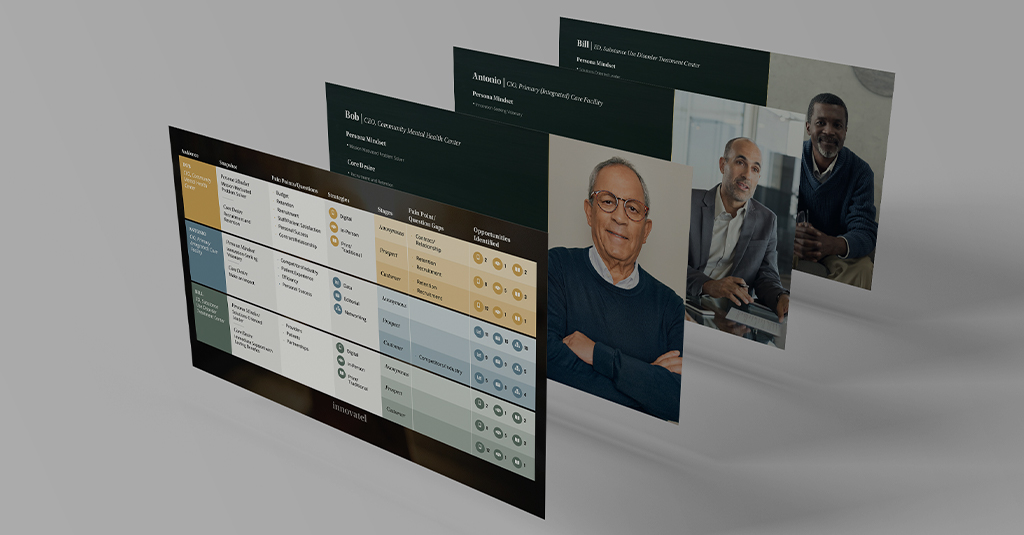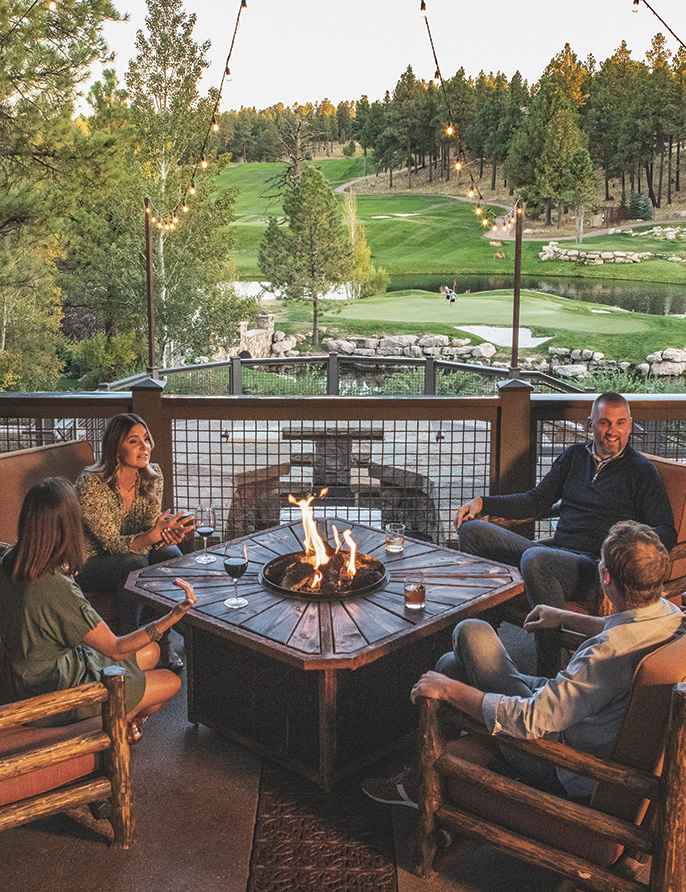Author: WHYFOR News
Understanding Bob: Audience Personas At Work


When we talk about “audience work,” that might sound vague. It might conjure a scene of someone tapping a hot mic, tossing out jokes, trying to warm up a studio full of fans awaiting a headliner.
We’re not talking about an opening act. We’re talking about targeted outreach informed by an in-depth analysis of who a specific brand or organization is trying to reach. There’s a big difference.
Much like opening acts like to tailor their set to the type of audience that appreciates the headliner (think: skip the ballads for the headbanging crowd), brands need to tailor their messaging to speak to the challenges, pain points and solutions their audiences are experiencing. This gets to the heart of WHYFOR’s Audience Personas.
It’s how innovaTel, a national telepsychiatry provider that partners with community-based organizations to improve access to care, better understands Bob.
And who’s Bob? He’s a composite character we developed during our Audience Persona process to help us, and innovaTel, get a better picture of what matters to someone managing a community mental health center.
And we didn’t just pluck him out of thin air. That’s what magicians do. Instead, we determined target audiences during a thorough workshop with innovaTel and gathered intel through a series of validation interviews from other Bob-types — none of whom were named Bob — to understand the pressures, goals and opportunities a professional in this field faces when trying to deliver care and improve outcomes for patients.

It was during those interviews that we discovered how Bob likes to receive information, what type of information he’s interested in receiving and how the information helps him, and other decision makers on his team, move forward with a new partner. Every Bob is different, but we were still able to see themes emerge that allowed us to create an illustration of a valuable audience specific to innovaTel.
And for innovaTel, we went through the same process with two other audiences because we understand the importance of nuance.
With those characters outlined, and then colored in thanks to first-party research, innovaTel came away from our Audience Persona work with a more informed visual of exactly who they’re talking to, and exactly how they should approach each of the audiences they’re trying to reach.
Like magic. Or an opening act that makes sure it knows who it’s playing to.
How well do you know your brand’s audience? Let us introduce you to Audience Personas.
Big Game Blowoffs: No Guts, No Glory


You can’t see me right now, but I’m starting a slow clap. Because it’s exciting to see brands that are daring enough, even during “unprecedented” times, to tackle a marketing landscape that has become so tricky it has scared the gnarly, big dogs from the yard.
I’m talking about the Big Game. Specifically, brands like Chipotle, Mercari and Fiverr. Those Big Game newcomers are seizing an opportunity to have millions of eyes on them for 30 whole seconds for the low-low price of $5.5 million, despite the “let’s-walk-on-eggshells” energy out there right now.
But, more importantly, those guys have a firm grip on who they are. That’s why they can afford to dive into this thing as soda and beer kingpins opt for the sidelines. For the record, we’re cool with Bud sitting out since they’re funding vaccines and all, but what has you so scared, Coke? I’d be more spooked about staying on the bench — looking at you, Pepsi.
Why? Because the companies that don’t take their foot off the gas during recessions score — pun somewhat intended. Statistics show brands that lean in and push ahead with growth and investment experience 277% more growth than brands that pull back.
That’s why $5.5 million, if you’ve got it, is the easiest decision ever. It’s impossible to argue with that kind of success.
Yes, Chipotle — spend that cash! Because I’ve seen what happens when companies decide to double-down during economic downturns instead of sitting in a bunker and waiting for the storm of the moment to pass.
But let me be clear — as a fiscally responsible branding veteran, I’m not advocating for companies to start throwing cash around that they don’t have. There’s strategy in everything, and it all begins with authenticity, which by its very nature can’t be engineered.
The CEO of Mercari, an online marketplace advertising in the Big Game for the first time this year, totally gets what I’m saying, and I’ve never even met the guy. He told Variety that his team went with its “gut and heart” when it developed their spot for the game.
Isn’t that where authenticity lies? Inside, in a brand’s gut? The answer is yes.
It’s why, at WHYFOR, we believe so ferociously in working with brands to ensure they understand their anatomy — the “who” and the “why” of what they are. When companies know that, and embrace it, they don’t have to walk the tightrope that so many of today’s brands are trying to do.
They want to be light-hearted and funny, but not disconnected. They want to match the tone of the nation, but don’t want to come across as somber. They don’t know how to support causes because they don’t even know if they believe in them.
That tightrope is a dangerous, ambiguous gamble. Authenticity is the safe bet, even when it costs $5.5 million.
As far as I’m concerned, first-timers like Mercari, Scotts Miracle-Gro, Chipotle and Fiverr are in the driver’s seat this weekend, no matter what. I mean, we’re talking about them, I’m already slow-clapping them, and I’m about to Google Triller — because they’re advertising, too, and I’m not ashamed to say I’m lost on who the heck they are.
But after Sunday, everyone will know.
It’s Effective. But What Does Anatomy Profile Work Feel Like?


After diving in and completing an Anatomy Profile with WHYFOR, Pine Canyon — a luxury golf community in Flagstaff, Arizona — experienced pretty remarkable results.
While doubling down during the pandemic on its new-found identity as a refuge for its owners and members, Pine Canyon crushed its sales goals (by 53%), saw a spike in SEO traffic (248% increase) and realized a 1,993% return on investment for its marketing efforts.
Deanna Keck, designated broker and sales executive for Symmetry Realty Brokerage at Pine Canyon, participated in the entire process. So, we asked her what she thought of it. Here’s what she said.
Q: What was the Anatomy Profile process like for you? What was your perception?
A: It revealed people to us. We always knew we were drawing from five different zip codes. And we knew friends wanted their neighbors close. A lot of people consider Pine Canyon summer camp. I think it helped us look inwards at just a lot of things we were doing to attract those people and to raise the bar.
If we follow these steps and really reflect on who our audience is, and the anatomy of who we are, we can take Pine Canyon to the next level.
Q: What do you think was the most beneficial element of the process?
A: It gave us a real roadmap of where we were and where we wanted to go. It always gave us the opportunity to bring us back to where we needed to be. We sit where we are today with the refresh of the brand … it allowed for Pine Canyon to set the bar extremely high.
Q: How do you think the work done during the Anatomy Profile impacted your external audiences?
A: We did a really great job of painting a beautiful picture for people to fall in love with. And we had the right people in the right seats to sell the lifestyle.
Q: How did it change how you do business, if it did?
A: I 100 percent believe in what the process brought to us and it really revealed a lot about our company we needed to change. And if other brands are committed to self-reflecting, they’ll get to where they want to go. This is a process for someone who is dedicated. Someone who says, “I want to do everything I can do to get there.” That’s the buy-in you have to get. I know it will make business better.
There are a lot of things that come through the process that are like skeletons in the closet. If you don’t deal with it, you can’t move forward. “Are you ready to make this commitment?” This is hard work. This is like therapy. And therapy is not fun. But when you work through it all, it’s amazing where you can be on the other side. If you can’t approach it that way, you don’t benefit from it.
… and we do believe we heard a mic drop right there, so we’ll wrap it up.
What can WHYFOR’s Anatomy Profiles do for your organization?
Connect with us and let’s find out, together.
When One Word Changes Everything


Sometimes, it’s hard to understand a concept until it’s drawn out, with specifics. We’re thinking about architecture and physics and (gulp) algebra. The Anatomy Profiles we do for brands are the same, except less terrifying than tricky math problems with letters.
We can talk about Anatomy Profiles and explain them, but they sometimes just need a real-world example so they can be easily digested. Pine Canyon, a luxury golf community in Flagstaff, Arizona, is the ideal illustration of the impact our Anatomy Profiles, the first step of our L.A.B.S. system, can have.
Prior to working with WHYFOR, Pine Canyon was selling houses. Pretty straight forward for any developer. To be specific, the community tucked into the Ponderosa pines of northern Arizona, was selling luxury cabins with list prices that many times required multiple commas.
Anyone who stepped foot onto the immaculate grounds at Pine Canyon, which enjoys views of the San Francisco Peaks and frequent visits from area wildlife, could feel that the community was special. It wasn’t just another housing development, with a playground and a bank of mailboxes.
Pine Canyon was a destination, and one’s arrival there meant something. And that feeling needed to be communicated — because, up until then, it wasn’t. Pine Canyon wasn’t using language that inspired its audience to act. It wasn’t conveying its unique benefits, beyond a house.
WHYFOR stepped in and changed that. Anatomy Profile work uncovered a unique differentiation for Pine Canyon, which was actually selling a home — a place where someone belongs — instead of just a dwelling. A minor but gigantic detail.
How gigantic?
After implementing tactics drawn from the Anatomy Profile, Pine Canyon’s leads increased by 40% and the real estate team exceeded sales goals by 53%.
That’s some math we can get behind. Our case study, though, illustrates all the results.
Anatomy: Pine Canyon

Client Background
Pine Canyon is a private golf community in Flagstaff, Arizona. The community’s luxury cabins offer owners an escape among pines, mountains and premium amenities infused with a sense of hospitality that isn’t easily found in a residential setting. Pine Canyon pivots on providing opportunities for its owners to discover a coveted, balanced life at every turn.
The Challenge
After being purchased by a new ownership group during the thick of the Great Recession, Pine Canyon experienced modest success but was still unable to meet or beat investor pro forma, despite offering a unique experience for its owners and members. The messaging being used was not connecting with its desired audience in a way that would inspire buyers to act. Pine Canyon needed to stand out from its competitors in the space and it needed to better understand, and more appropriately relay, its value to its audience.
The Tools

The Opportunity
Designed as a retreat for its owners, Pine Canyon’s most appealing attribute is its role as a genuine refuge for those who purchase a home in the community. Through its Anatomy Profile work, part of WHYFOR’s proprietary L.A.B.S. process, WHYFOR determined Pine Canyon, to that point, was trying to sell houses, dwellings where someone lives. But they really needed to sell homes — a place where someone belongs.
Why? Because that’s what their buyers craved.
WHYFOR’s Anatomy Profile determined Pine Canyon was more than a neighborhood. It was a place to disconnect in order to reconnect — a sought-after escape filled with indulgence, serenity, hospitality and luxury. WHYFOR worked to ensure that its branding would reflect its anatomy.


The creative concept:
Messaging and muted but sensory-rich visuals became key elements of Pine Canyon’s new look and feel as a result of WHYFOR’s Anatomy Profile. A messaging matrix developed with desired language for Pine Canyon acted as a reference tool for all branding efforts, creating a direct connection between buyers and the feeling they get when they’re at Pine Canyon.
A new tagline, “A refuge for the human spirit,” captured the essence of everything Pine Canyon offers — a place to belong.
The aha moment:
Once WHYFOR completed its Anatomy Profile and developed messaging that more appropriately reflected Pine Canyon’s DNA, the branding quickly began to resonate with prospective buyers, with owners and with staff. Pine Canyon became known as a true refuge, where members play world-class golf, owners take advantage of opportunities to explore and experience indulgent luxuries, and real estate options allow for the creation of a legitimate retreat from all of life’s typical distractions.
WHYFOR recognizes that the success of Anatomy Profile work is difficult to measure. How, after all, does one measure a feeling?
When it takes hold — that’s when. When PGA golfers reference the messaging. When a sales team adopts and leverages strategic phrasing. And, when prospective buyers use the same language about Pine Canyon that they’re consuming.
Numbers tell the story, too, as WHYFOR used its Anatomy Profile work as a strong, strategic foundation for its tactical plans. The results?



Assume Your Assumptions Are No Good


We’ve finally reached the meat, the juicy stuff. That sounds weird without context, but for carnivores, it must sound like some kind of glorious summit.
In reality, it’s exciting for everyone, even vegetarians. Because this is the culmination of the work we’ve been unfolding over the past few weeks as we explain our H.A.L.O. business system, a unique and holistic approach to branding and marketing based on values and rooted in immersive behavioral analysis.
We’ve mapped a brand’s genetic code, we’ve contextualized personas and the customer journey, and we’ve created a customized plan, based on budgets and goals, for a brand to realize the kind of success that — to this point — has alluded it.
We know. It sounds like magic or wild theory or even one of those “but wait there’s more” kind of things. But, it’s not. It’s just an industry-agnostic system that works.
Because everyone’s desire for something that works is equal. It’s not dependent on the size of the investment, whether your marketing budget is 20 bucks, $20,000 or $2 million. You want a return that is worth something. And that return, be it qualified leads, improved awareness or increased conversions, can translate to improved reputation, additional revenue or better recognition in a crowded marketplace.
That’s why our Avenues Plan drills down to specifics, providing exact coordinates for the placement of marketing dollars based on the work completed throughout the entire process. And oftentimes, by the time we arrive here, we are coordinating a solution for an issue that a brand had misdiagnosed, or completely missed, at the outset.
But that’s what this process is for. While it’s not designed to manufacture a branding curveball, it often uncovers unexpected insights, like archeologists dusting off generations of failed assumptions.
Data takes you down the correct paths. Assumptions, most times, don’t.
We could go on and on and on about this stuff, about H.A.L.O., about how well it works and about how much we love digging in and discovering new things about brands and businesses. But, we can’t here.
We’ve got anatomies to code, audiences to dissect and avenues to plan. Want in? Let us know. We’ll get these things going for you, too.
Cruise The Express Lane, Without Carpooling


Road trips have changed over the years. Where our parents would unfold accordion-style maps that seemingly ate up all the space in the front seat, a generation later we’re able to demand directions from a handheld computer, using just our voices.
The common thread? We need a route. Or, we’ll be lost.
Sometimes, if it’s really uncharted territory, we even need a guide. That’s what WHYFOR’s Avenues assessment, part of our H.A.L.O. business system, provides. It leads to a guided tour of the route a brand should take to reach its target audiences, based on its anatomy, its personas and its budget.
Yeah, like any road trip, there’s math involved. But numbers offer clarity and valuable perspective, like gas mileage. You need to know how far you can go with what you have, and which route would be the most efficient and most effective to take.
It makes total sense. But many times, brands or businesses bypass this type of thing. They throw everything in the car and take the route they know, even if it’s entirely uphill. Or, in marketing talk, they allocate their marketing budgets based on old information, tired habits and whatever everyone else is doing.
Despite being trendy, crop tops aren’t for everyone. Twitter isn’t, either. Certain approaches are better for certain types of brands or businesses. And our Avenues assessment sorts all that out.
Imagine that. Imagine knowing exactly who you are, as a brand, knowing exactly how to speak to your audiences because you’ve studied their behaviors, and then knowing exactly which routes to take to reach them. That type of intel changes things, in a good way.
It builds recognition. It improves reputation. If done properly, it drives revenue and it can improve retention. And, it threads together a brand’s DNA, its relationships and the outflow of measurable ROI.
There’s more to the process (think: incredible, insight-driven, customized plan), and we’ll dive into that soon. But, if you can’t wait, call us. We can be persuaded (easily) to talk about our Avenues assessment and its benefits.
Hey. Personas Have Lives, Too.


We’re all trackable. Like, even if we think we’re private, we’re actually not. We have our habits, our favorite Instagrammers and we gravitate towards brands and ideas that predictably sync with our personalities
and passions.
We can be found. And we are, regularly. Which means, brands should take note.
So, when we finish painting the detailed illustrations of our Audience Personas for clients at WHYFOR, we start following the breadcrumbs that sprinkle out from that work — work that identifies with low ambiguity who a business or brand or organization is trying to reach, with specificity. And once we follow those breadcrumbs, we animate the characters we’ve carved out during persona development, folding who they are and how they’re motivated into a blueprint that details where they can be found and how they can be reached.
This entire process, the one we refer to as H.A.L.O., builds on itself as we progress. So, if any of this sounds out there or if you feel like you’ve walked into the middle of a conversation — you have, a little. If you start from the beginning, it all makes sense.
But, now that we’re here, it’s time to consider the customer journey. At WHYFOR, we take a deeply empathetic approach to mapping and fully understanding the journey a persona will take with a brand. Beyond technical UX, we get down to routines. We explore the nitty gritty in a strategic, sensible way.
In short, based on the pain points and motivators we discovered while piecing together personas, we find where a brand fits in a consumer’s orbit. Is it at a conference or trade show (think pre- or post-COVID)? Is it on TikTok or LinkedIn? Is it online, outdoors or in an inbox? Or is it (gasp) over the phone?
And when we reach them, how should we talk to them? Based on what we know, what should we develop that they’d appreciate? A handy download, a fun video or an informative white paper? It all depends.
Our Audience Persona work isn’t complete until we know these things. Think of it as coloring in a picture after outlining it in great detail. It’s all about the shading, right?
The part that cannot be overlooked is that we can’t reach this point, effectively, without doing all the groundwork first. We can’t know how a brand fits into a consumer’s life until we know what the brand stands for and what the consumer looks like.
In other words, you can’t understand your specific audience until you understand yourself — as a business. It’s deep. And life advice-like. But true.
We’re walking clients through it all right now. And to our knowledge, no one has cried yet, except in celebration. We’re not even making that up.
Let us know when you’re ready to dive into your own journey.
Guess Who You’re Talking To? That’s So Old School


Hasbro sells a board game that asks players to use physical characteristics to guess the identity of a secret person their opponent has chosen. Remember that game, Guess Who? It’s a simple premise.
Is it a woman? Does she have glasses? Does he have a mustache? Is her hair red? That kind of thing.
On the most elementary level, and we mean at its most simplistic, it reminds us of the Audience Personas we create as part of our proprietary H.A.L.O. process. Instead of flipping down illustrations of people who don’t fit the persona we’re creating, like we would in the game, we use gigantic sticky notes or digital templates to build profiles of the types of people brands are trying to reach.
It’s a process, a fun, insightful one. It starts where our Anatomy Profile leaves off and leads to the development of an Avenues Plan. On its own, Audience Personas uncover not just how a segment of an audience looks and lives, but how they think, how they behave and what motivates them to act.
This is where things start to fit together. It’s where pieces start to slide into place, and where clients begin to understand why we questioned them about their anatomy and their values so relentlessly and specifically. Because, you have to know who you are and how people view you in order to know who you want to talk to and understand why they would want to hear you.
We could get fancy here and talk about psychographics and demographics, and then pick apart the delineations and necessities of both. But we won’t. We’re going to go Guess Who?-style and keep it simple. Because that falls in line with our approach. We ditch those traditionally bloated and often fluffy reports that never get used in favor of creating specific, actionable plans that feed off our Anatomy Profiles and move us to our customer journey analysis.
Audience Personas get to the root of why people make the choices they do, as it relates to brands. Our ultimate goal is to get to the nerve, to discover the pain point and then understand what factors motivate certain behaviors. Put simply, we want to understand pain points to alleviate them, understand questions audiences have so we can answer them and understand goals so we can help them achieve them.
The data we bring to the surface allows us to create a valuable narrative, featuring fictional characters based on a brand’s true story — like a high-quality, super-specific docudrama. And like any juicy drama, some of the characters (or personas) are driven by money (budgets), some by fame (personal notoriety), some by philosophies and principles (classic Cinderella/Jedi story).
Regardless, those unique motivations are the holy grail. Because ultimately, we want our work to influence decision making and impact revenue.
See? It’s a bit more high level than Guess Who?, but we also don’t shout “Cheater!” like we did as kids as we work through Audience Personas. We’re past that.
And once we’re past harvesting characteristics for brand-specific personas, we build them out so they’re easier to see. We’ll explain that process a bit more, soon.
Need some intel on your Audience Personas? Let’s talk.
How We Put Anatomy Profiles To Work


Discovering who you are can be a trip. On a personal level, that discovery may come in the wake of turbulent trials or while backpacking through the Sierra Nevada mountains or after stumbling through the desert at Burning Man. Different strokes for different folks.
But for brands that work with us, that discovery is born during a thorough analysis of organizational structure, ideals, process and purpose. We’ve talked about it before — the Anatomy Profile we work with brands to create.
And we imagine you probably want to know what comes next. Because getting information is easy, even if it feels hard in the moment. Using it is the real challenge.
We’ve seen too many brands and organizations pay for marketing research or marketing plans or marketing tactics that they never put to use — or don’t even know how to use.
It. Just. Sits. There. And gets stale. And sad.
We’re not into that. So, we put hard work to work, insisting that the time we’ve spent uncovering a brand’s DNA is never wasted. We’re kind of like drill sergeants for insights, without those annoying whistles.
Once we understand a brand’s anatomy, we build out a complete profile. We know who you are now, so we find out how you’d speak to the people you’re trying to reach. But it’s not just about how you talk — it’s also about what
you say.
Anatomy Profiles include the development of core messages, a sort of content compass, informing content plans for any number of platforms, from taglines to digital ads to tweets. These core messages steer your content creation, ensuring a brand’s anatomy shines through, consistently, with every word.
Anatomy work has the potential to uncover a more applicable direction for a brand or organization, and often does. Because it drills down to a common denominator (no fractions needed) and builds a fresh foundation that otherwise may have gone undiscovered.
It’s the whole “forest for the trees” thing.
The entire process allows a brand to reset or rediscover how it wants to make people feel and how it wants to be viewed. Once that self-discovery is done, the army of insights turn and face the audience, because that’s their
next mission.
The information gained from the development of Anatomy Profiles trickles up, if you can visualize that anomaly. It improves your understanding of and ability to convey your unique differentiators in the tone that fits your brand and your audiences.
It’s a delicate dance, and if done properly, can positively impact organizational struggles related to recruitment, retention and recognition, among other issues that start with the letter “r.” There actually are a few more.
And once it’s complete, we start looking at Audience Personas. The Anatomy Profile flows right into it, like a hand into a glove — a working glove made of leather or suede instead of a fancy, white one from those old English shows.
Because, like we said, we put this work to work. Intrigued? Our Anatomy Profile work is something we love to talk about, so let’s connect.
